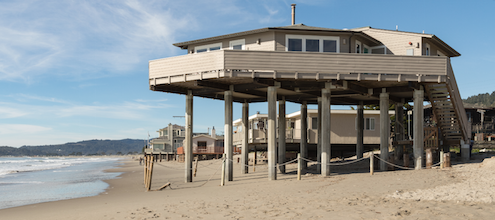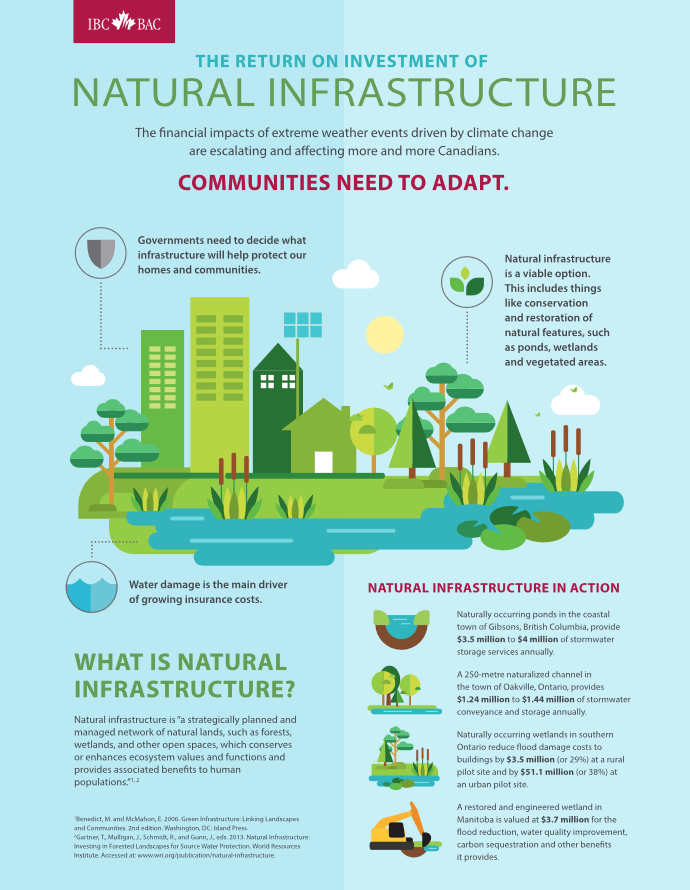
Climate Roulette: Reducing risk through adaptation
Even if the world stopped emitting GHGs today, we’d still face dangerous sea-level rise, hotter temperatures, and more extreme weather events caused by our past emissions. Preparing and planning for these risks—some of which were explained in last week’s blog—can reduce how much damage they ultimately inflict on our health, economy, environment, and communities. That is, smart adaptation policies can reduce our collective risk and keep costs down.
This third instalment of our blog series on climate risk takes a look at adaptation policy and the role that ecofiscal policies can play in Canada. Our goal here is to provide a window into adaptation policy issues, not to be comprehensive. Adaptation is a complex, sprawling issue that cuts across multiple dimensions of public policy. (See here, here, and here for more research on the topic.)
Adaptation as risk management
Essentially, adaptation is about planning for current and future emissions levels and taking actions to become more resilient to climate risk. That means reducing the chance that damage from climate change will be severe and costly.
Adaptation can look different depending on where you are. Adapting to sea level rise is very different than adapting to pervasive drought, which is very different than adapting to the increased risk of forest fires, which is very different than adapting to freak storms, which is very different than adapting to urban heatwaves, which is…
You get the point. In many cases adaptation is a local problem that demands local solutions. A dollar spent protecting Richmond’s shoreline in BC will have different benefits than a dollar spent protecting the shorelines in St. John, NB. No single tool can do everything, and each comes with different costs and benefits. At the same time, when adding up all of these local risks, it’s clear that provincial and national governments should play a critical role in helping communities adapt.
Ecofiscal adaptation
The adaptation policy toolkit is broad and diverse. But here, we’ll stick to our own expertise. A handful of ecofiscal solutions can help drive low-cost adaptation and reduce the chance of costly damage from climate change:
- Municipal user fees for water, wastewater, and stormwater can help make these essential services more resilient. Fees for water and wastewater can help curb unsustainable water consumption, allowing supplies to last longer during dry spells. Stormwater user fees can encourage property owners to pave less and seed more, reducing runoff and flood risk. And all three types of user fees provide a critical source of revenues for municipalities, which can ensure that resilient infrastructure is built and maintained.
- Properly valuing natural ecosystems can also play an important role in climate adaptation. Natural ecosystems are a key line of defence against climate change (e.g., water purification and flood control from wetlands, clean drinking water from lakes and aquifers, etc.) and also help store carbon emissions. Simply allowing municipalities to value ecosystems on their balance sheets can make our towns and cities more resilient. It would allow municipalities to integrate the costs of protecting natural ecosystems into how they budget and set user fees, encouraging both full-cost recovery and healthier ecosystems. It would help justify spending money to protect our most valuable adaptation assets.
Source: Insurance Bureau of Canada, 2018
- Finally, ecofiscal policies can help correct incentives in insurance markets. In some cases, the risks from climate change may not be properly baked into insurance premiums. Fully and accurately pricing risk discourages people from buying properties in low-lying or coastal areas prone to flooding. This type of market-based policy can replace more heavy-handed approaches, such as banning development entirely.
Tip of the iceberg
These ecofiscal policies— important as they are—barely scratch the surface of adaptation policy. In many cases, adaptation policy is more about providing resources—for planning, infrastructure, capacity-building—and less about fixing markets. And for any one climate risk (e.g., sea-level rise, extended droughts, nastier hurricanes) there might be a dozen ways that governments can respond.
At the same time, meeting Canada’s urgent need for stronger and more comprehensive adaptation measures will be costly. The City of Calgary, for example, has committed to spend over $150 million for flood mitigation. Separating stormwater and wastewater pipes in Charlottetown, PEI, which reduces flooding risk during heavy rainfall, was over $18 million. Building dykes to protect Richmond BC could cost over $300 million. These are just three examples.
So how can governments choose adaptation policies that are cost-effective? While we don’t have all the answers, some basic principles can help.
- Relying on the best available data and information. Smart adaptation policies require up-to-date climate modelling so that researchers and governments can properly assess risk exposure. Ideally, this type of assessment is done at the community level, so that the most exposed and sensitive areas get priority. This triage process can direct resources to their most efficient use.
- Conducting rigorous cost-benefit analysis. Not all adaptation policies pass a cost-benefit test. Some policies may be extremely expensive and derive few benefits. Cost-benefit analyses can help governments make difficult decisions about how to best adapt and where to spend scarce dollars. Critically, these analyses should consider social and environmental benefits that are often difficult to quantify and monetize.
- Re-evaluating and reassessing. Adaptation is a dynamic process. Climate risks are always changing, and history is no longer a guide for what we can expect in the future. Smart, cost-effective adaptation policy is therefore a constant process of assessment, action, reassessment, learning, and response. Adaptation should be a priority when building new infrastructure or re-building after disasters.
- Taking adaptation mainstream. The need for adaptation spans multiple areas of public policy: agriculture, transportation, health, infrastructure, finance, etc. Cost-effective solutions will require unprecedented levels of coordination and communication between (and within) governments, the private sector, and other stakeholders. Such collaboration and planning can ensure resources go to where they’re most needed and avoid duplication.
Planning for rising tides
From a risk management perspective, adapting to climate change is a clear way to reduce the potential damages from climate change. That is, it can make good financial sense to implement policy now to protect lives and assets from future harm, even if the exact timing and severity of risk is uncertain. And the more cost-effective we can make our adaptation policy, the more we have money to spend on other things.
Finally, adaptation is only part of the story. Adapting to a warming world is important, but so too is reducing the risk of a changing climate in the first place. Our future emissions will determine “how bad” climate risks become and therefore by how much we need to adapt. Next week’s blog completes our series by returning to our research specialty: mitigation.





Comments are closed.